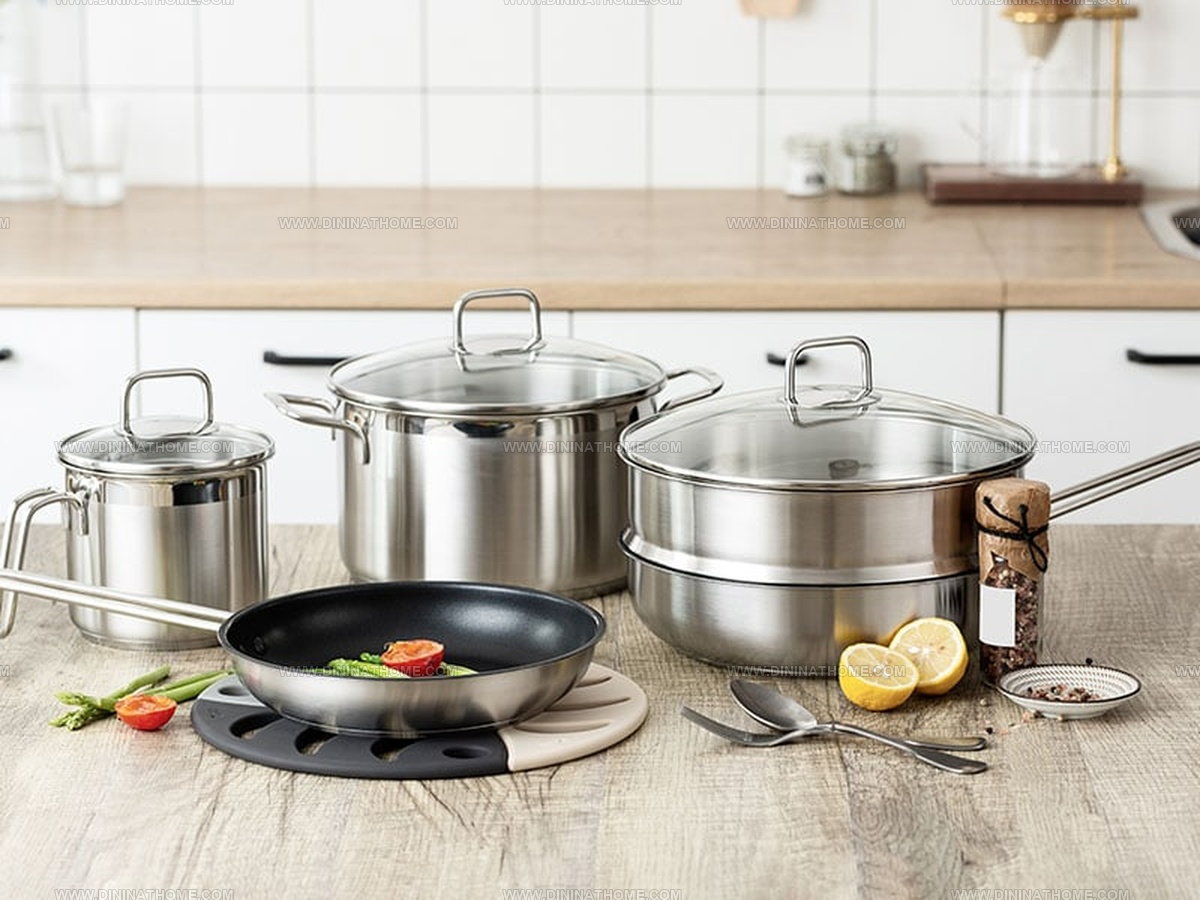Saucepan or Pot: What’s Right for Your Kitchen?
Saucepans and pots play crucial roles in every busy kitchen.
Essential tools help us create everything from hearty soups to delicate sauces with remarkable ease.
Most home cooks reach for them daily without considering their subtle design differences.
The distinct shapes actually serve very specific culinary purposes that can affect cooking results.
Mastery of both vessels allows for greater flexibility when tackling complex recipes at home.
The next sections will explain exactly how to choose between these kitchen staples for perfect results every time you cook.
Understanding Saucepans: The Complete Guide
Saucepans feature steep sides, a narrow base, a long single handle, and a flat bottom, with deeper sides than saute or frying pans. The base sits wider than a frying pan but narrower than a saute pan, while the handle makes carrying heavy liquids much easier.
During cooking, this handle allows for simple stirring and whisking, and most saucepans include a lid to lock in heat and moisture. Thanks to high, straight sides, saucepans work wonderfully for handling all kinds of liquids - from reducing sauces to simmering, blanching vegetables, and stewing.
Material options for saucepans include stainless steel, aluminum, copper, and nonstick surfaces, each with different benefits.
The Overview of Pot
A pot is a versatile, deep cooking vessel designed for boiling, simmering, stewing, and braising a variety of foods.
Typically larger and deeper than pans or skillets, pots often come with two small handles on either side for easy lifting, and many include a tight-fitting lid to retain heat and moisture during cooking.
Pots are ideal for preparing soups, stocks, pasta, and large batches of food due to their capacity and ability to distribute heat evenly.
Common materials for pots include stainless steel, aluminum, cast iron, and sometimes nonstick coatings, each offering different benefits like durability, heat conduction, and ease of cleaning.
Saucepan vs. Pot: Know What Makes Each Unique
Stainless steel and nonstick cookware serve different purposes in the kitchen, though many dishes can be made in either type.
Check out the below table to a quick comparison.
| Feature | Saucepan | Pot |
| Appearance | Narrower base, shorter sides, long single handle for easy carrying | Larger base, higher sides, two loop handles for stability |
| Capacity | Typically 1-4 quarts, suitable for small volumes like sauces or reheating for 1-2 people | Varies widely, commonly 8-20 quarts; 12 quarts ideal for large batches |
| Uses | Best for sauces, stews, heating liquids quickly, blanching, reheating; heats rapidly but food can burn easily | Ideal for slow cooking, braising, bulk cooking like stocks; slow evaporation due to tall sides |
| Price | Generally more affordable due to smaller size; price influenced by brand and material | Usually more expensive due to larger size and material; brand and material also affect cost |
Appearance
A saucepan is characterized by its narrower base and shorter sides compared to a pot. This design makes it especially suitable for cooking smaller volumes of liquids and food.
The long handle attached to the saucepan offers ease and convenience in handling and transporting it, particularly when stirring or pouring. In contrast, a pot features a larger base and taller sides, designed to accommodate cooking larger quantities of food or liquids.
Most pots come with two sturdy loop handles (except for Dutch ovens), which provide stability and make it easier to lift and carry heavy contents safely. This clear difference in shape and handle design reflects their distinct purposes in the kitchen.
Capacity
Saucepans typically come in sizes ranging from 1 to 4 quarts, which makes them perfect for everyday cooking tasks like preparing sauces, boiling a single serving of pasta, or reheating small portions. For instance, a 1-quart saucepan is ideal for heating a small amount of soup or sauce, while a 4-quart version can handle reheating stews or making a meal for two.
On the other hand, pots vary greatly in capacity, from 8 to as much as 20 quarts or more, with 12 quarts being a popular size for many households. Such large capacities make pots perfect for cooking meals for larger groups or preparing big batches of noodles, soups, or stocks.
The size difference is one of the main factors guiding which cookware to choose for a specific cooking need.
Uses
Saucepans are specifically designed for tasks that involve small volumes of liquid, such as making sauces or stews. Their narrow base and tall sides ensure heat surrounds the food evenly, which helps thicken sauces quickly and intensifies flavors.
Because of their smaller size, saucepans heat up liquids rapidly, making them an excellent choice for boiling pasta, blanching vegetables, or reheating small dishes. However, the quick heating can be a double-edged sword, as food can easily burn or stick if not monitored carefully.
Pots, conversely, are preferred for slow cooking methods such as braising or simmering due to their taller sides that reduce evaporation. Their large capacity makes them indispensable for cooking in bulk, such as preparing stocks or feeding larger groups, where slow and even cooking over time is needed.
Price
Price is another important consideration when choosing between a saucepan and a pot. Because saucepans are smaller, they generally require fewer materials in their production, which tends to make them more affordable compared to pots.
However, the price can vary widely depending on the material used, such as stainless steel, copper, or cast iron, and the brand behind the product. For example, a copper saucepan from a premium brand may cost significantly more than a basic cast iron pot from a mid-range manufacturer.
Similarly, larger pots often command higher prices due to their size and the amount of material needed to produce them.
Deciding Between Saucepans and Pots
Saucepans and pots serve different cooking needs with their own advantages and limitations. From heating liquids and thickening sauces quickly in small batches, saucepans excel when space is limited and portions are modest - just remember to stir frequently to prevent burning.
Pots shine when cooking larger quantities thanks to their wide, spacious design that accommodates more ingredients at once. These larger vessels make all the difference for slow-cooked dishes and braised recipes where food needs room to develop flavor.
The best choice depends entirely on what dishes appear most often on your menu and how many people typically gather around your table for meals.
Swap Saucepans for Pots? Yes, With a Few Simple Tricks!
Saucepans can take over pot duties for many recipes including soups, pasta, and rice, making them quite versatile in the kitchen. Their only real drawback compared to pots is their more limited capacity.
Pots heat liquids more slowly than saucepans, which adds extra cooking time when you're boiling water or preparing small food portions.
The design of pots with their tall sides and wider bases might affect how your sauces thicken, potentially changing both flavor and texture in ways you didn't intend.
Shopper’s Guide to Perfect Pots and Pans
When choosing the perfect cookware for your kitchen, many factors go beyond just the type of pot or saucepan. Here are some key points to consider.
Saucepan vs. Pot: Which Is More Useful?
Saucepans and pots each have versatile uses, but their value depends on your cooking needs.
Saucepans are great for small to medium liquids and precise tasks like sauces or reheating, thanks to their narrow, tall shape for even heating.
Pots, with larger capacity and wider bases, excel at cooking bigger meals, slow-cooking, and boiling large batches. While saucepans heat quickly and are easy to handle, pots offer the space needed for hearty dishes.
Having both in your kitchen ensures you’re prepared for a wide range of cooking tasks.
Smart Storage Hacks For Pots and Pans
Looking after your favorite saucepans and pots ensures they won't scratch or warp after just a few years. Proper storage starts with reading care instructions from manufacturers who know their products best.
For your nonstick cookware, wooden or silicone tools work better than metal ones which can damage surfaces, while cast iron can handle metal utensils without problems.
Many people stack their pots to save space, but this often leads to unwanted scratches and chips; hanging each piece on separate hooks protects them better.
After cooking, let your pots cool down completely before washing them - cold water on hot cookware causes thermal shock that can crack or damage them permanently.
Before turning up the heat, make sure to add some oil, butter or water to your nonstick pans, as empty pans on high heat may release toxins and reduce their lifespan significantly.
Got Questions? We’ve Got Solutions
1. Can I use a saucepan instead of a pot?
Yes, for smaller portions. Saucepans work well for sauces, grains, and small batches of soup, but pots are better for large quantities like pasta, stews, and stock.
2. Why do saucepans have long handles while pots have two short handles?
Saucepans have long handles for easy one-handed maneuvering and tossing ingredients. Pots have two short handles because they're typically heavier and require two hands to lift safely.
3. Which is better for boiling water?
Pots are generally better for boiling water because they have a larger capacity and wider opening that allows water to evaporate more efficiently. Saucepans work for small amounts but may boil over easily.
4. Do professional chefs prefer saucepans or pots?
Professional chefs use both for different purposes. Saucepans for precise cooking of sauces and small dishes, pots for large-batch cooking like soups and stocks.


James Walker
Lead Recipe Developer & Culinary Educator
Expertise
Southern Cuisine & Farm-to-Table Cooking, Recipe Development & Testing, Culinary Education & Instruction
Education
School: Auguste Escoffier School of Culinary Arts
Program: Diploma in Culinary Arts and Operations
Focus: Comprehensive training in classical and modern culinary techniques, kitchen operations, and farm-to-table practices.
James didn’t learn cooking from a TV show, he learned it from busy kitchens, family gatherings, and long afternoons spent testing recipes the hard way.
After training at the Auguste Escoffier School of Culinary Arts, he brought his love for real, down-to-earth food to every dish he makes.
At Dining At Home, James loves building recipes that feel familiar but still have something special, like adding a twist to a classic or making a slow Sunday dinner feel brand new.
When he’s not in the kitchen, you’ll probably find him swapping garden tips at the farmers’ market or teaching his daughter how to flip pancakes without a mess (almost).